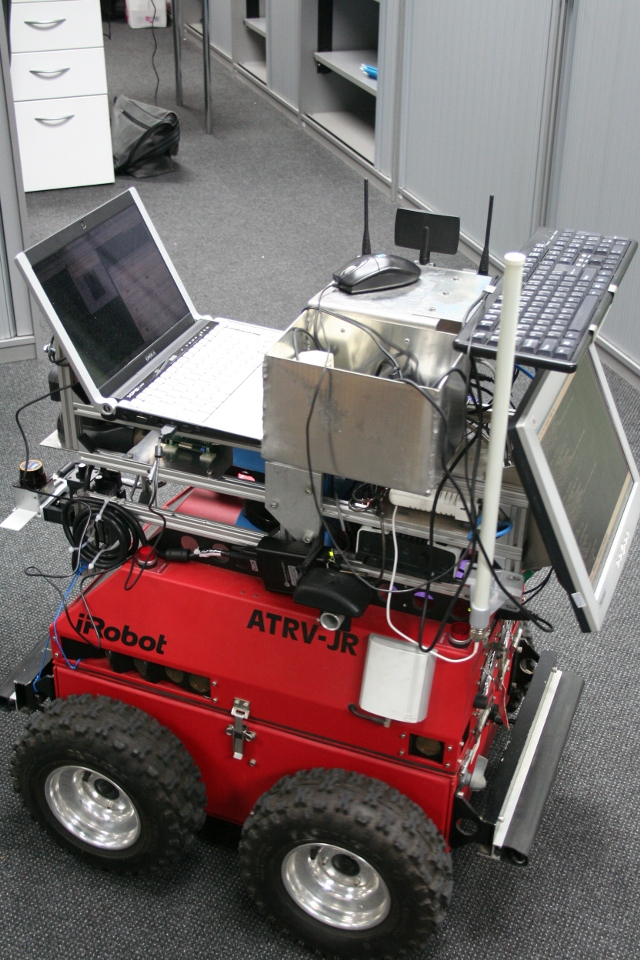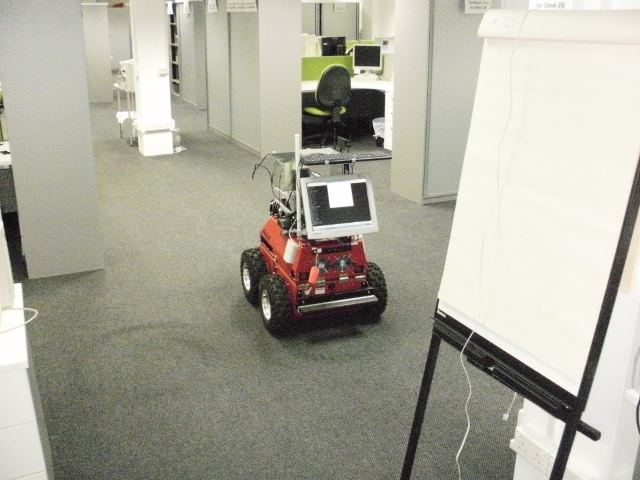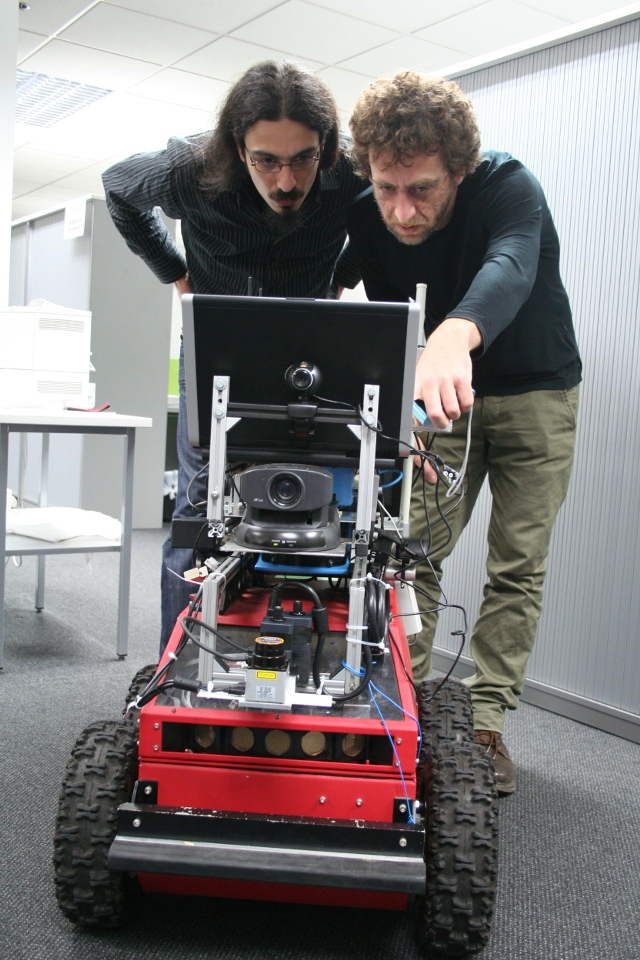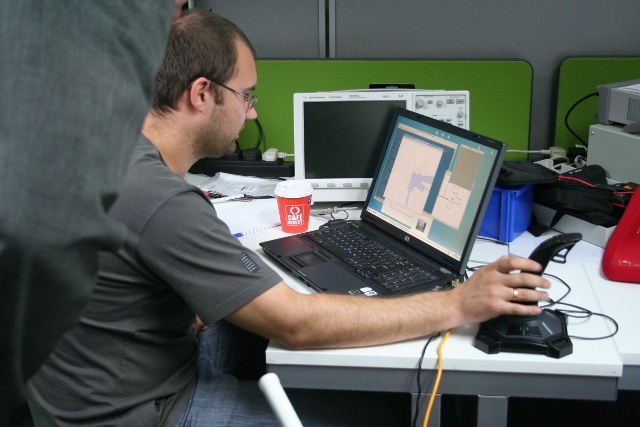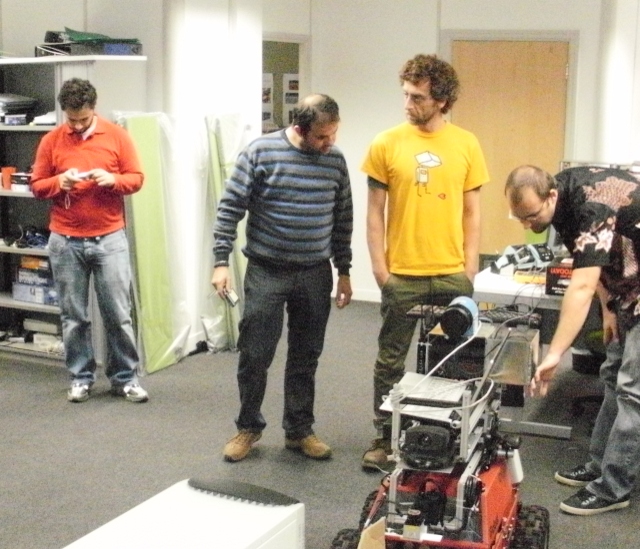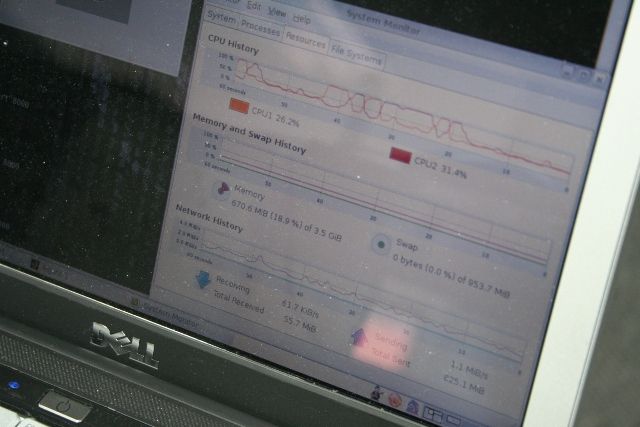VIEW-FINDER
m (#([http://cordis.europa.eu/fetch?CALLER=PROJ_IST&ACTION=D&RCN=80499 Project Number 045541]).) |
m (→Objective) |
||
| Line 40: | Line 40: | ||
| − | + | [[VIEW-FINDER]] is a field (mobile) robotics project, consisting of 9 European partners, that seeks to use semi-autonomous mobile robot platform to establish ground safety in the event of a fire. Its primary aim is to gather data (visual and chemical) to assist fire rescue personnel after a disaster has occured. A base station will combine gathered information with information retrieved from the large scale GMES-information bases. | |
This project will address key issues related to 2.5D map building, localisation and reconstruction; interfacing local command information with external sources; autonomous robot navigation and human-robot interfaces (base-station). Partners PIAP, UoR, SHU and IES are pre-dominantly involved in the indoor scenario and RMA, DUTH predominately involved in the outdoor scenario; with SAS and SyFire being involved in both. | This project will address key issues related to 2.5D map building, localisation and reconstruction; interfacing local command information with external sources; autonomous robot navigation and human-robot interfaces (base-station). Partners PIAP, UoR, SHU and IES are pre-dominantly involved in the indoor scenario and RMA, DUTH predominately involved in the outdoor scenario; with SAS and SyFire being involved in both. | ||
| − | The developed VIEW-FINDER system will be a complete semi-autonomous system; the individual robot-sensors operate autonomously within the limits of the task assigned to them, that is, they will autonomously navigate through and inspect an area. Central operations | + | The developed VIEW-FINDER system will be a complete semi-autonomous system; the individual robot-sensors operate autonomously within the limits of the task assigned to them, that is, they will autonomously navigate through and inspect an area. Central operations control will assign tasks to the robots and just monitor their execution. However, Central operations control has the means to renew task assignments or detail tasks of the ground robot. System-human interactions at the Central operations control will be facilitated through multi modal interfaces, in which graphical displays play an important but not exclusive role. |
Although the robots will have the ability to operate autonomously, human operators can monitor the robots' processes and send high level task requests, as well as low level commands, through the human-computer interface to some nodes of the ground system. The human-computer interface (base station) has to ensure that a human supervisor and human interveners on the ground, are provided with a reduced yet relevant overview of the area under investigation including the robots and human rescue workers therein. | Although the robots will have the ability to operate autonomously, human operators can monitor the robots' processes and send high level task requests, as well as low level commands, through the human-computer interface to some nodes of the ground system. The human-computer interface (base station) has to ensure that a human supervisor and human interveners on the ground, are provided with a reduced yet relevant overview of the area under investigation including the robots and human rescue workers therein. | ||
Revision as of 01:49, 25 November 2009
Contents |
The VIEW-FINDER project
In the event of an emergency, due to a fire or other crisis, a necessary but time consuming pre-requisite, that could delay the real rescue operation, is to establish whether the ground can be entered safely by human emergency workers. The objective of the VIEW-FINDER project is to develop robots which have the primary task of gathering data. The robots are equipped with sensors that detect the presence of chemicals and, in parallel, stereo/mono image and ladar data are collected and forwarded to an ergonomically designed base station. The project comprises of two scenarios: indoor and outdoor.
Notifications and Announcements
- You are advised to visit the official VIEW-FINDER page: "Vision and Chemi-resistor Equipped Web-connected Finding Robots".
- Disclaimer: In this page you will be viewing pre-dominantly the indoor scenario even though we have tried for most of the information provided herein to be from the project as a whole. To the best of our knowledge the information provided herein are correct at the time of publication.
-
 IARP workshop RISE 2010 at Sheffield Hallam University on 20-21 January 2010. Further details available here.
IARP workshop RISE 2010 at Sheffield Hallam University on 20-21 January 2010. Further details available here.
Objective
 |
The VIEW-FINDER project is a European-Union, Framework-VI funded program (Project Number 045541).
VIEW-FINDER is a field (mobile) robotics project, consisting of 9 European partners, that seeks to use semi-autonomous mobile robot platform to establish ground safety in the event of a fire. Its primary aim is to gather data (visual and chemical) to assist fire rescue personnel after a disaster has occured. A base station will combine gathered information with information retrieved from the large scale GMES-information bases.
This project will address key issues related to 2.5D map building, localisation and reconstruction; interfacing local command information with external sources; autonomous robot navigation and human-robot interfaces (base-station). Partners PIAP, UoR, SHU and IES are pre-dominantly involved in the indoor scenario and RMA, DUTH predominately involved in the outdoor scenario; with SAS and SyFire being involved in both.
The developed VIEW-FINDER system will be a complete semi-autonomous system; the individual robot-sensors operate autonomously within the limits of the task assigned to them, that is, they will autonomously navigate through and inspect an area. Central operations control will assign tasks to the robots and just monitor their execution. However, Central operations control has the means to renew task assignments or detail tasks of the ground robot. System-human interactions at the Central operations control will be facilitated through multi modal interfaces, in which graphical displays play an important but not exclusive role.
Although the robots will have the ability to operate autonomously, human operators can monitor the robots' processes and send high level task requests, as well as low level commands, through the human-computer interface to some nodes of the ground system. The human-computer interface (base station) has to ensure that a human supervisor and human interveners on the ground, are provided with a reduced yet relevant overview of the area under investigation including the robots and human rescue workers therein.
The project was coordinated by the Materials and Engineering Research Institute at Sheffield Hallam University and officially ended on 30th November 2009, with final reports and demos completed on Jan 2010.
Partners
Coordinator
- SHU: Sheffield Hallam University, Materials and Engineering Research Institute (MERI, MMVL), Sheffield, United Kingdom
Academic Research Partners
- RMA: Royal Military Academy - Patrimony, Belgium
- DUTH: Democritus University of Thrace - Xanthi, Greece
- UoR: Sapienza University of Rome, Italy
- PIAP: Industrial Research Institute for Automation and Measurements - PIAP, Poland
Industrial partners
- SAS: Space Applications Services, Belgium
- IES: Intelligence for Environment and Security SRL - IES Solutions SRL, Italy
- SyFire: South Yorkshire Fire and Rescue Service, United Kingdom
- GA: Galileo Avionica -S.P.A., Italy
Software that has proven useful
- System architecture/integration
- Mapping and Localisation
External Links
- Source of Inspiration - Robotics
- Other related
- NASA Three-Robot System for Traversing Steep Slopes
- BBC news: robotic firefighting
- Channel 4 News: Rise of the Machines?
- Robot mining trucks
- Robots can jump...
- DEFACTO fire-training software
- NIST Christmas tree fire video
- NIST's FDS-SMV fire dynamics simulator (also see comparison of real and simulated fire)
See Also
- Publicity
Videos and results
|
A prototype of the ViewFinder SLAM procedure based on an SIR-RB particle filter implementation: ladar and odometry data collected via the Player software platform.
|
A video demonstration of the base-station controlling the ATRV-Jr robot through the Human-Machine interface. Different views and control means are shown.
|
More to add here |
|
Nitrogen gas evolution in a room-fire scenario (simulated with NIST's FDS-SMV); a vertical and horizontal plane are only shown with the fire start indicated by a yellow patch.
|
Outdoor trials at the Royal Military Academy outdoor robot (RMA) and Base Station (SAS); a glimpse of the indoor ATRV-jr robot (PIAP) can also be seen.
|
X-addition |
| X-addition | X-addition | More to be added here |
